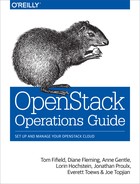Chapter 14. Backup and Recovery
Standard backup best practices apply when creating your OpenStack backup policy. For example, how often to backup your data is closely related to how quickly you need to recover from data loss.
If you cannot have any data loss at all, you should focus on High Availability as well as backups.
Other backup considerations include:
-
How many backups to keep?
-
Should backups be kept off-site?
-
How often should backups be tested?
Just as important as a backup policy is a recovery policy (or at least recovery testing).
What to Backup
While OpenStack is composed of many components and moving parts, backing up the critical data is quite simple.
This chapter describes only how to back up configuration files and databases that the various OpenStack components need to run. This chapter does not describe how to back up objects inside Object Storage or data contained inside Block Storage. Generally these areas are left for the user to back up on their own.
Database Backups
The example OpenStack architecture designates the Cloud Controller as the MySQL server. This MySQL server hosts the databases for Nova, Glance, Cinder, and Keystone. With all of these databases in one place, it’s very easy to create a database backup:
# mysqldump --opt --all-databases >
openstack.sqlIf you only want to backup a single database, you can instead run:
# mysqldump --opt nova > nova.sqlwhere nova is the database you want to back
up.
You can easily automate this process by creating a cron job that runs the following script once per day:
#!/bin/bash
backup_dir="/var/lib/backups/mysql"
filename="${backup_dir}/mysql-`hostname`-`eval date +%Y%m%d`.sql.gz"
# Dump the entire MySQL database
/usr/bin/mysqldump --opt --all-databases | gzip > $filename
# Delete backups older than 7 days
find $backup_dir -ctime +7 -type f -deleteThis script dumps the entire MySQL database and delete any backups older than 7 days.
File System Backups
This section discusses which files and directories should be backed up regularly, organized by service.
Compute
The /etc/nova directory on both the
cloud controller and compute nodes should be regularly
backed up.
/var/log/nova does not need backed up if
you have all logs going to a central area. It is
highly recommended to use a central logging server or
backup the log directory.
/var/lib/nova is another important
directory to backup. The exception to this is the
/var/lib/nova/instances subdirectory
on compute nodes. This subdirectory contains the KVM
images of running instances. You would only want to
back up this directory if you need to maintain backup
copies of all instances. Under most circumstances, you
do not need to do this, but this can vary from cloud
to cloud and your service levels. Also be aware that
making a backup of a live KVM instance can cause that
instance to not boot properly if it is ever restored
from a backup.
Image Catalog and Delivery
/etc/glance and
/var/log/glance follow the same rules
at the nova counterparts.
/var/lib/glance should also be backed up.
Take special notice of
/var/lib/glance/images. If you are
using a file-based back-end of Glance,
/var/lib/glance/images is where the
images are stored and care should be taken.
There are two ways to ensure stability with this directory. The first is to make sure this directory is run on a RAID array. If a disk fails, the directory is available. The second way is to use a tool such as rsync to replicate the images to another server:
# rsync -az --progress /var/lib/glance/images backup-server:/var/lib/glance/images/
Identity
/etc/keystone and
/var/log/keystone follow the same
rules as other components.
/var/lib/keystone, while should not
contain any data being used, can also be backed up
just in case.
Block Storage
/etc/cinder and
/var/log/cinder follow the same rules
as other components.
/var/lib/cinder should also be backed
up.
Object Storage
/etc/swift is very important to have
backed up. This directory contains the Swift
configuration files as well as the ring files and ring
builder files, which if
lost render the data on your cluster inaccessible. A
best practice is to copy the builder files to all
storage nodes along with the ring files. Multiple
backups copies are spread throughout your storage
cluster.
Recovering Backups
Recovering backups is a fairly simple process. To begin,
first ensure that the service you are recovering is not
running. For example, to do a full recovery of nova on the
cloud controller, first stop all nova
services:
# stop nova-api
# stop nova-cert
# stop nova-consoleauth
# stop nova-novncproxy
# stop nova-objectstore
# stop nova-schedulerOnce that’s done, stop MySQL:
# stop mysqlNow you can import a previously backed up database:
# mysql nova < nova.sqlAs well as restore backed up nova directories:
# mv /etc/nova{,.orig}
# cp -a /path/to/backup/nova /etc/Once the files are restored, start everything back up:
# start mysql
# for i in nova-api nova-cert nova-consoleauth nova-novncproxy nova-objectstore nova-scheduler
> do
> start $i
> done
Other services follow the same process, with their respective directories and databases.
